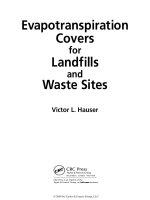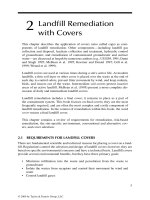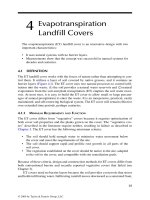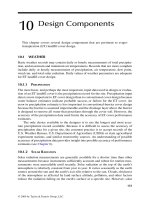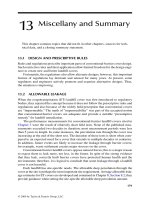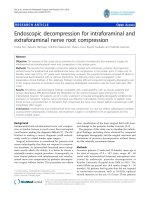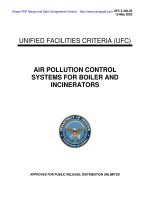Ship Stability for Masters and Mates 5 Episode 13 doc
Bạn đang xem bản rút gọn của tài liệu. Xem và tải ngay bản đầy đủ của tài liệu tại đây (452.64 KB, 35 trang )
Specimen examination papers 409
Present displacement 5400 t, which includes the following:
Inclining weight 25 t, Kg 7.94 m.
Fuel oil 50 t, Kg 2.30 m, FSM 640 t m.
The inclining weight is moved 14.0 m transversely producing a
de¯ection of 27 cm in a plumbline of length 9.0 m. (20)
DATASHEET Q.1
(This Datasheet must be returned with your answer book). Note `foap' denotes for'd of AP
Hydrostatic Particulars `A'
Draught Displacement TPC MCTC KM
T
KB LCB LCF
m t t t m foap foap
SW FW SW FW SW FW
RD 1.025 RD 1.000 RD 1.025 RD 1.000 RD 1.025 RD 1.000 m m m m
7.00 14 576 14 220 23.13 22.57 184.6 180.1 8.34 3.64 70.03 67.35
6.90 14 345 13 996 23.06 22.50 183.0 178.5 8.35 3.58 70.08 67.46
6.80 14 115 13 771 22.99 22.43 181.4 177.0 8.36 3.53 70.12 67.57
6.70 13 886 13 548 22.92 22.36 179.9 175.5 8.37 3.48 70.16 67.68
6.60 13 657 13 324 22.85 22.29 178.3 174.0 8.38 3.43 70.20 67.79
6.50 13 429 13 102 22.78 22.23 176.8 172.5 8.39 3.38 70.24 67.90
6.40 13 201 12 879 22.72 22.17 175.3 171.0 8.41 3.33 70.28 68.00
6.30 12 975 12 658 22.66 22.11 173.9 169.6 8.43 3.28 70.32 68.10
6.20 12 748 12 437 22.60 22.05 172.5 168.3 8.46 3.22 70.35 68.20
6.10 12 523 12 217 22.54 21.99 171.1 167.0 8.49 3.17 70.38 68.30
6.00 12 297 11 997 22.48 21.93 169.8 165.7 8.52 3.11 70.42 68.39
5.90 12 073 11 778 22.43 21.87 168.5 164.4 8.55 3.06 70.46 68.48
5.80 11 848 11 559 22.37 21.82 167.3 163.2 8.59 3.01 70.50 68.57
5.70 11 625 11 342 22.32 21.77 166.1 162.1 8.63 2.95 70.53 68.65
5.60 11 402 11 124 22.26 21.72 165.0 161.0 8.67 2.90 70.57 68.73
5.50 11 180 10 908 22.21 21.66 163.9 160.0 8.71 2.85 70.60 68.80
5.40 10 958 10 691 22.15 21.61 162.9 158.9 8.76 2.80 70.64 68.88
5.30 10 737 10 476 22.10 21.56 161.8 157.9 8.81 2.74 70.68 68.95
5.20 10 516 10 260 22.05 21.51 160.8 156.9 8.86 2.69 70.72 69.02
5.10 10 296 10 045 22.00 21.46 159.8 155.9 8.92 2.63 70.75 69.09
5.00 10 076 9830 21.95 21.41 158.8 154.9 8.98 2.58 70.79 69.16
4.90 9857 9616 21.90 21.36 157.9 154.0 9.06 2.53 70.82 69.23
4.80 9638 9403 21.85 21.32 156.9 153.1 9.13 2.48 70.86 69.29
4.70 9420 9190 21.80 21.27 156.0 152.2 9.22 2.43 70.90 69.35
4.60 9202 8978 21.75 21.22 155.1 151.3 9.30 2.38 70.93 69.42
4.50 8985 8766 21.70 21.17 154.2 150.5 9.40 2.32 70.96 69.48
4.40 8768 8554 21.65 21.12 153.3 149.6 9.49 2.27 71.00 69.55
4.30 8552 8344 21.60 21.07 152.4 148.7 9.60 2.22 71.04 69.62
4.20 8336 8133 21.55 21.02 151.5 147.8 9.71 2.17 71.08 69.68
4.10 8121 7923 21.50 20.97 150.6 146.9 9.83 2.12 71.12 69.74
4.00 7906 7713 21.45 20.93 149.7 146.0 9.96 2.07 71.15 69.81
3.90 7692 7505 21.40 20.88 148.7 145.1 10.11 2.01 71.18 69.88
3.80 7478 7296 21.35 20.83 147.8 144.2 10.25 1.96 71.22 69.94
3.70 7265 7088 21.30 20.78 146.8 143.3 10.41 1.91 71.25 70.00
3.60 7052 6880 21.24 20.72 145.9 142.3 10.57 1.86 71.29 70.07
3.50 6840 6673 21.19 20.67 144.9 141.3 10.76 1.81 71.33 70.14
THESE HYDROSTATIC PARTICULARS HAVE BEEN DEVELOPED WITH THE VESSEL FLOATING ON EVEN KEEL
412 Ship Stability for Masters and Mates
DATASHEET Q.1
(N.B. This Datasheet must be returned with your examination answer book)
TABULATED KN VALUES `A'
KN values in metres
KN values calculated for vessel on an Even Keel and ®xed trim.
Displacement Angle of Heel (Degrees)
(tonne)
12 20 30 40 50 60 75
15 000 1.72 2.98 4.48 5.72 6.48 6.91 7.05
14 500 1.73 2.98 4.51 5.79 6.58 6.95 7.08
14 000 1.74 2.98 4.55 5.85 6.68 7.00 7.10
13 500 1.75 2.99 4.58 5.90 6.73 7.08 7.13
13 000 1.77 3.00 4.62 5.93 6.78 7.14 7.16
12 500 1.78 3.03 4.63 5.98 6.83 7.18 7.18
12 000 1.78 3.05 4.65 6.04 6.88 7.20 7.20
11 500 1.80 3.12 4.70 6.10 6.93 7.25 7.22
11 000 1.82 3.15 4.75 6.15 6.98 7.30 7.24
10 500 1.83 3.19 4.79 6.18 7.02 7.35 7.27
10 000 1.86 3.23 4.83 6.22 7.07 7.40 7.30
9500 1.93 3.28 4.91 6.25 7.11 7.45 7.35
9000 2.00 3.36 5.00 6.28 7.18 7.50 7.40
8500 2.05 3.43 5.04 6.32 7.20 7.55 7.41
8000 2.10 3.52 5.10 6.36 7.22 7.60 7.42
7500 2.17 3.62 5.18 6.38 7.24 7.65 7.46
7000 2.22 3.70 5.25 6.40 7.26 7.70 7.50
6500 2.32 3.85 5.35 6.43 7.27 7.70 7.51
6000 2.42 4.00 5.45 6.48 7.28 7.70 7.52
5500 2.57 4.15 5.55 6.53 7.29 7.68 7.51
5000 2.72 4.32 5.65 6.58 7.30 7.66 7.50
KN values are for hull and forecastle only.
Specimen examination papers 413
SHIP STABILITY
Attempt ALL questions
Marks for each question are shown in brackets
1. Ship `A' has a displacement of 14 000 tonne and a KG of 8.20 m.
Using Datasheets Q.1 Tabulated KN Values and Hydrostatic Particulars,
determine whether the vessel complies with the stability requirements of
the current Load Line Rules. (35)
2. A box shaped vessel ¯oating at an even keel in salt water has the
following particulars:
Length 75.00 m Breadth 18.00 m Depth 11.0 m
Draft 6.00 m KG 6.80 m
An empty midship watertight compartment 15.00 m long is bilged.
Calculate EACH of the following:
(a) the new draft; (8)
(b) the GM in the ¯ooded condition; (12)
(c) the righti ng moment at an angle of 16 degrees. (15)
3. (a) Describe, with the aid of a sketch, the forces that cause a vessel to
heel when turning. (12)
(b) A vessel turns in a circle of diameter 200 m at a speed of 16 knots.
GM 0.78 m. BG 0.88 m. g 9.81 m/sec
2
(Assume 1 knot
1.8532 km/hr).
Calculate the angle of heel due to turning. (18)
4. (a) Describe the hydrostatic, stability and stress data required to be
supplied to ships. (30)
(b) A maximum draft forward is sometimes stated in the above data
when supplied to the ship under the Load Line Rules.
State the reason for this limitation. (5)
5. A vessel with a high deck cargo will experience adverse effects on its
stability due to strong beam winds on lateral windage areas.
With the aid of a sketch, show the minimum stability requirements, with
respect to wind heeling, under current regulations. (35)
6. With regard to the inclining experiment:
(a) state its purpose; (5)
(b) describe the precautions to be taken before and during the
experiment; (16)
(c) list the circumstances when the experiment is required to take
place. (9)
COMMAND ENDORSEMENT (LIMITED EUROPEAN)
Ship Construction and Stability
2 hours. Attempt all questions. Marks for each question are shown in brackets.
1. A ship has a light displacement 435 tonnes with KG 3.25 m.
On board this ship there are 40 tonnes of fuel, water, stores and crew
effects at Kg 3.80 m with a free surface moment of 35 t m.
The single hold is rectangular of length 40 m, width 9.4 m and depth
5.1 m and is to be ®lled with a bulk cargo (stowage factor 1.4 m
3
/tonne).
When ®lled the Kg of the hold is 3.34 m.
Calculate the GM of the ship in its loaded condition if the loaded KM is
4.05 m (30)
2. A ship is at displacement 1700 tonnes with draughts 3.20 m forward
4.05 m aft. The following is the appropriate hydrostatic data:
Length BP: 55 m TPC: 5.2 MCTC: 22.8
Centre of Flotation 2.5 m abaft amidship.
Calculate:
(a) the drafts forward and aft produced by loading 100 tonnes 40 m
forward of the aft perpendicular; (20)
(b) from the initial condition, the weight to load 37 m forward of the
aft perpendicular to bring the ship to a trim of 0.6 m by the stern.
3. Use Worksheet Q.3: Simpli®ed Stability ± Deadweight Moment Curve.
(Ensure that all points plotted on the diagram can be identi®ed in the
working).
The load displacement is 1175 tonnes.
The ships present condition: displacement 800 tonnes.
Deadweight moment 600 t m.
Cargo to be loaded: 250 tonnes at Kg 2.8 m.
From the above condition:
(a) Determine the maximum weight of cargo that can be taken at Kg
4.5 m so that stability is adequate. (10)
(b) It is anticipated that 30 tonnes of fuel and water at Kg 1.6 m will
be used on passage producing a free surface moment of 100 t m.
Determine the maximum weight of cargo that can be loaded at
Kg 4.5 m so that stability is adequate on arrival at the discharge
port. (20)
4. (a) Explain clearly the meaning of the term `reserve buoyancy'. (15)
(b) Describe the items that maintain the integrity of reserve buoyancy
giving a brief indication of any maintenance that may be required.
(15)
5. (a) (i) Sketch a typical GZ curve for a stable ship and indicate the
features that may be found from it. (15)
(ii) The ship in (a) (i) is now further loaded with deck cargo. Show on
the same curve how the GZ might change due to this. (7)
414 Ship Stability for Masters and Mates
(b) A ship is at a certain draught and displacement.
Sketch two GZ curves on the same axes to show this ship in a stiff
and a tender condition.
(8)
WORKSHEET Q.3
(N.B. The Worksheet must be returned with your examination answer book. Ensure that all
points plotted on the diagram can be identi®ed in the working)
COMMAND ENDORSEMENT (EXTENDED EUROPEANS)
Ship Construction and Stability
3 hours. Attempt all questions. Marks for each question are shown in brackets.
1. A ship has a light displacement of 2700 tonnes and KG 6.50 m. The load
displacement of 11 800 tonnes has an associated KM 6.60 m. The
following are to be taken on board:
Fuel and FW: 520 tonnes at Kg 0.60 m
Stores: 100 tonnes at Kg 4.50 m
A full cargo is then to be loaded in the tween deck at Kg 8.20 m and
hold at Kg 5.00 m to give a sailing GM of 1.00 m.
Specimen examination papers 415
Calculate how much of the cargo should be loaded in the:
(i) tween deck;
(ii) hold (35)
2. The GZ values of a vessel at a certain displacement are as shown:
Heel (y
) 0 15 30 45 60 75
GZ (m) 0 0.27 0.73 0.95 0.61 0.06
KM: 9.00 m KG 8.20 m
(a) Plot the GZ curve on the graph paper provided. (10)
(b) Calculate the area under the curve between 0
and 30
using
Simpson's Rules. (15)
(c) Show that the curve satis®es the stability criteria required by the
Load Line Rules 1968. (10)
3. MV Mexna (2) is ¯oa ting at draughts 6.40 m forward and 7.60 m aft.
Using the hydrostatic data provided (Worksheet Q.3) calculate:
(a) the amount of ballast to load into the forepeak tank (c.g. 60 m
forward of amid-ships) so that the draught aft is 7.30 m; (25)
(b) the ®nal draught forward. (10)
4. Explain with reference to a well labelled sketch, how the effect of free
surface can be considered as a reduction in a vessel's metacentric height.
(35)
5. (a) List the requirements of the Load Line Rules 1968, relating to
weathertight doors. (10)
(b) Describe the maintenance and testing of a superstructure door in
order to ensure weathertightness. (20)
6. Illustrate by means of labelled half mid-section sketches each of the
following framing systems:
(i) Transverse; (10)
(ii) Longitudinal; (10)
(iii) Combination. (10)
416 Ship Stability for Masters and Mates
WORKSHEET Q.3 Hydrostatic Curves for Mexna (2)
(N.B. This worksheet must be returned with your answer book)
COMMAND ENDORSEMENT
(EXTENDED EUROPEAN)
DATASHEET Q.5
This Datasheet must be returned with your answer book
HYDROSTATIC PARTICULARS `B'
(in salt water R.D. 1.025)
The hydrostatic particulars have been calculated for the vessel on Even Keel.
Draught (m) Displacement (t) TPC (t) MCTC (tm) LCB from LCF from KB (m) KM
T
(m)
amidships (m) amidships (m)
4.00 1888.8 5.20 23.30 1.45 A 2.39 A 2.09 4.05
3.90 1836.8 5.20 23.20 1.42 A 2.43 A 2.04 4.05
3.80 1784.8 5.19 23.10 1.39 A 2.46 A 1.99 4.05
3.70 1733.0 5.18 22.99 1.36 A 2.49 A 1.93 4.06
3.60 1681.2 5.17 22.89 1.32 A 2.52 A 1.88 4.06
3.50 1629.5 5.16 22.77 1.29 A 2.55 A 1.83 4.07
3.40 1577.9 5.16 22.65 1.24 A 2.57 A 1.78 4.09
3.30 1526.4 5.15 22.52 1.20 A 2.59 A 1.72 4.11
3.20 1475.1 5.13 22.39 1.15 A 2.61 A 1.67 4.13
3.10 1423.8 5.12 22.25 1.10 A 2.62 A 1.62 4.15
3.00 1372.6 5.11 22.11 1.04 A 2.63 A 1.56 4.19
2.90 1321.5 5.10 21.96 0.98 A 2.64 A 1.51 4.22
2.80 1270.6 5.09 21.80 0.91 A 2.64 A 1.46 4.27
2.70 1211.4 5.07 21.64 0.84 A 2.64 A 1.40 4.32
2.60 1169.1 5.06 21.47 0.76 A 2.63 A 1.35 4.37
2.50 1118.6 5.05 21.30 0.68 A 2.63 A 1.30 4.44
2.40 1068.4 5.01 20.87 0.59 A 2.51 A 1.24 4.51
Specimen examination papers 419
SHIP CONSTRUCTION AND STABILITY
Attempt ALL questions
Marks for each question are shown in brackets
1. A vessel of 5200 tonne displacement has a KG of 4.32 m and is listed
2.5
to starboard. KM 5.50 m (assumed constant).
The following cargo operations take place:
Load: 125 tonne Kg 2.45 m and 4.85 m to starboard of centreline.
Discharge: 280 tonne Kg 3.55 m and 1.50 m to starboard of centreline.
Calculate EACH of the following:
(a) the resulting angle of list; (25)
(b) the angle of list if a slack tank containing salt water and with a fresh
water free surface moment of 900 t m is also considered. (10)
2. A ship is ¯oating at drafts 7.25 m forward and 8.45 m aft and has to pass
with an underkeel clearance of 0.5 m over a bar with a depth of 8.5 m.
The following hydrostatic particulars apply:
Length BP: 180 m
LCF: 3 m aft of amidships
MCTC: 200
After peak tank: Lcg 2 m aft of AP
Fore peak tank: Lcg 173 m for'd of AP
Calculate EACH of the following:
(a) the amount of water ballast to transfer from the after peak to the
fore peak to enable the bar to be crossed with minimum clear-
ance; (25)
(b) the ®nal drafts forward and aft. (10)
3. A rectangular shaped vessel of length 50 m and breadth 8 m ¯oats on an
even keel draft of 1.50 m in salt water at a KG of 2.50 m.
500 tonne is now loaded at Kg 2.20 m.
Calculate the vessel 's righting moment at 5
heel for the loaded
condition. (35)
4. Explain, with the aid of sketches, how the stability of a vessel is affected
by an increase in EACH of the following:
(a) KG; (15)
(b) Freeboard. (20)
5. (a) `When a ship is ¯oating out of design trim, the true mean draft (or
draft at the centre of ¯otation) and not the arithmetic mean draft (or
draft at amidships), must be used with the hydrostatic data in order
to obtain the correct displacement.'
For a ship ¯oating with a trim by the stern and LCF abaft amidships,
explain, with reference to a sketch EACH of the following:
420 Ship Stability for Masters and Mates
(i) how the true mean draft is obtained; (10)
(ii) why it would be incorrect to use the arithmetic mean draft. (5)
(b) A ship of length BP 56 m is ¯oating at draughts 2.70 m forward and
3.00 m aft.
Using Hydrostatic Particulars `B' Datasheet Q.5:
Calculate the vessel's true mean draught and displacement. (15)
6. Illustrate EACH of the following with labelled sketches:
(a) the sheer/stringer strake connection at a deck transverse frame
station; (10)
(b) a duct keel; (10)
(c) the watertight closing (or sealing) arrangements for a deep tank
lid. (10)
Specimen examination papers 421
DATASHEET Q.3
(N.B. This Datasheet must be returned with your examination answer book)
TABULATED KN VALUES `A'
KN values in metres
KN values calculated for vessel on an Even Keel and ®xed trim.
Displacement Angle of Heel (Degrees)
(tonne)
12 20 30 40 50 60 75
15 000 1.72 2.98 4.48 5.72 6.48 6.91 7.05
14 500 1.73 2.98 4.51 5.79 6.58 6.95 7.08
14 000 1.74 2.98 4.55 5.85 6.68 7.00 7.10
13 500 1.75 2.99 4.58 5.90 6.73 7.08 7.13
13 000 1.77 3.00 4.62 5.93 6.78 7.14 7.16
12 500 1.78 3.03 4.63 5.98 6.83 7.18 7.18
12 000 1.78 3.05 4.65 6.04 6.88 7.20 7.20
11 500 1.80 3.12 4.70 6.10 6.93 7.25 7.22
11 000 1.82 3.15 4.75 6.15 6.98 7.30 7.24
10 500 1.83 3.19 4.79 6.18 7.02 7.35 7.27
10 000 1.86 3.23 4.83 6.22 7.07 7.40 7.30
9500 1.93 3.28 4.91 6.25 7.11 7.45 7.35
9000 2.00 3.36 5.00 6.28 7.18 7.50 7.40
8500 2.05 3.43 5.04 6.32 7.20 7.55 7.41
8000 2.10 3.52 5.10 6.36 7.22 7.60 7.42
7500 2.17 3.62 5.18 6.38 7.24 7.65 7.46
7000 2.22 3.70 5.25 6.40 7.26 7.70 7.50
6500 2.32 3.85 5.35 6.43 7.27 7.70 7.51
6000 2.42 4.00 5.45 6.48 7.28 7.70 7.52
5500 2.57 4.15 5.55 6.53 7.29 7.68 7.51
5000 2.72 4.32 5.65 6.58 7.30 7.66 7.50
KN values are for hull and forecastle only.
DATASHEET Q.1(e)
(N.B This Datasheet must be returned with your examination answer book). Note: `foap' denotes for'd of AP
Hydrostatic Particulars `A'
Draught Displacement TPC MCTC KM
T
KB LCB LCF
m t t t m foap foap
SW FW SW FW SW FW
RD 1.025 RD 1.000 RD 1.025 RD 1.000 RD 1.025 RD 1.000 m m m m
7.00 14 576 14 220 23.13 22.57 184.6 180.1 8.34 3.64 70.03 67.35
6.90 14 345 13 996 23.06 22.50 183.0 178.5 8.35 3.58 70.08 67.46
6.80 14 115 13 771 22.99 22.43 181.4 177.0 8.36 3.53 70.12 67.57
6.70 13 886 13 548 22.92 22.36 179.9 175.5 8.37 3.48 70.16 67.68
6.60 13 657 13 324 22.85 22.29 178.3 174.0 8.38 3.43 70.20 67.79
6.50 13 429 13 102 22.78 22.23 176.8 172.5 8.39 3.38 70.24 67.90
6.40 13 201 12 879 22.72 22.17 175.3 171.0 8.41 3.33 70.28 68.00
6.30 12 975 12 658 22.66 22.11 173.9 169.6 8.43 3.28 70.32 68.10
6.20 12 748 12 437 22.60 22.05 172.5 168.3 8.46 3.22 70.35 68.20
6.10 12 523 12 217 22.54 21.99 171.1 167.0 8.49 3.17 70.38 68.30
6.00 12 297 11 997 22.48 21.93 169.8 165.7 8.52 3.11 70.42 68.39
5.90 12 073 11 778 22.43 21.87 168.5 164.4 8.55 3.06 70.46 68.48
5.80 11 848 11 559 22.37 21.82 167.3 163.2 8.59 3.01 70.50 68.57
5.70 11 625 11 342 22.32 21.77 166.1 162.1 8.63 2.95 70.53 68.65
5.60 11 402 11 124 22.26 21.72 165.0 161.0 8.67 2.90 70.57 68.73
5.50 11 180 10 908 22.21 21.66 163.9 160.0 8.71 2.85 70.60 68.80
5.40 10 958 10 691 22.15 21.61 162.9 158.9 8.76 2.80 70.64 68.88
5.30 10 737 10 476 22.10 21.56 161.8 157.9 8.81 2.74 70.68 68.95
5.20 10 516 10 260 22.05 21.51 160.8 156.9 8.86 2.69 70.72 69.02
5.10 10 296 10 045 22.00 21.46 159.8 155.9 8.92 2.63 70.75 69.09
5.00 10 076 9830 21.95 21.41 158.8 154.9 8.98 2.58 70.79 69.16
4.90 9857 9616 21.90 21.36 157.9 154.0 9.06 2.53 70.82 69.23
4.80 9638 9403 21.85 21.32 156.9 153.1 9.13 2.48 70.86 69.29
4.70 9420 9190 21.80 21.27 156.0 152.2 9.22 2.43 70.90 69.35
4.60 9202 8978 21.75 21.22 155.1 151.3 9.30 2.38 70.93 69.42
4.50 8985 8766 21.70 21.17 154.2 150.5 9.40 2.32 70.96 69.48
4.40 8768 8554 21.65 21.12 153.3 149.6 9.49 2.27 71.00 69.55
4.30 8552 8344 21.60 21.07 152.4 148.7 9.60 2.22 71.04 69.62
4.20 8336 8133 21.55 21.02 151.5 147.8 9.71 2.17 71.08 69.68
4.10 8121 7923 21.50 20.97 150.6 146.9 9.83 2.12 71.12 69.74
4.00 7906 7713 21.45 20.93 149.7 146.0 9.96 2.07 71.15 69.81
3.90 7692 7505 21.40 20.88 148.7 145.1 10.11 2.01 71.18 69.88
3.80 7478 7296 21.35 20.83 147.8 144.2 10.25 1.96 71.22 69.94
3.70 7265 7088 21.30 20.78 146.8 143.3 10.41 1.91 71.25 70.00
3.60 7052 6880 21.24 20.72 145.9 142.3 10.57 1.86 71.29 70.07
3.50 6840 6673 21.19 20.67 144.9 141.3 10.76 1.81 71.33 70.14
THESE HYDROSTATIC PARTICULARS HAVE BEEN DEVELOPED WITH THE VESSEL FLOATING ON EVEN KEEL
424 Ship Stability for Masters and Mates
SHIP CONSTRUCTION AND STABILITY
Attempt ALL questions
Marks for each question are shown in brackets
1. All parts of question 1 carry equal marks.
(a) De®ne Transverse Metacentre.
(b) De®ne Statutory Freeboard.
(c) State the meaning of watertight as given in the Load Line Rules 1968.
(d) A ship of displacement 15 000 t is heeled 3
. Given KG 8.46 m and
KM 9.36 m determine the Righting Moment.
(e) Use Datasheet Q.1(e).
The ship, length 145 m, is ¯oating in fresh water at drafts 4.30 m
Forward and 6.30 m Aft. Determine the ship's displacement. (35)
2. Use Datasheet Q.1(e).
The ship, at displacement 6950 t, KG 7.80 m loads the following:
2800 t at Kg 3.79 m
3400 t at Kg 6.86 m
900 t at Kg 8.89 m
500 t at Kg 10.30 m
On passage it is anticipated that 950 t of fuel and fresh water will be
used from Kg 2.85 m producing a free surface moment of 414 t m.
Calculate the GM on arrival. (30)
3. Use Datasheets Q.1(e) and Q.3.
The ship is at displacement 11 750 t, KG 8.00 m.
(a) Draw the GZ curve for the ship in this condition. (20)
(b) Using the curve drawn in Q.3(a), estimate EACH of the following:
(i) the angle of vanishing stability.
(ii) the angle of deck edge immersion .
(iii) the maximum GZ and the angle at which it occurs. (10)
4. Use Hydrostatic Datasheet Q.1(e).
The ship, length b.p. 140 m, is at drafts 6.10 m Forward and 6.50 m Aft.
100 t of ballast, already on board, is to be moved 85 m forward.
(a) Calculate the position, with reference to amidship, at which 227 t of
cargo should be loaded so that the ship ®nishes on an even keel.(20)
(b) Determine the ®nal draught. (10)
5. A ship of displacement 9500 t ¯oats upright in still water with KG
8.84 m and KM 9.96 m.
On passage containers of weight 65 tonne are lost overside from a
position Kg 12.0 m, 10.5 m to port of the centreline.
Calculate the list to be expected giving the direction. (25)
DATASHEET Q.4
(This Worksheet must be returned with your answer book)
HYDROSTATIC PARTICULARS `B'
(in salt water R.D. 1.025)
The hydrostatic particulars have been calculated for the vessel on Even Keel.
Draught (m) Displacement (t) TPC (t) MCTC (tm) LCB from LCF from KB (m) KM
T
(m)
amidships (m) amidships (m)
4.00 1888.8 5.20 23.30 1.45 A 2.39 A 2.09 4.05
3.90 1836.8 5.20 23.20 1.42 A 2.43 A 2.04 4.05
3.80 1784.8 5.19 23.10 1.39 A 2.46 A 1.99 4.05
3.70 1733.0 5.18 22.99 1.36 A 2.49 A 1.93 4.06
3.60 1681.2 5.17 22.89 1.32 A 2.52 A 1.88 4.06
3.50 1629.5 5.16 22.77 1.29 A 2.55 A 1.83 4.07
3.40 1577.9 5.16 22.65 1.24 A 2.57 A 1.78 4.09
3.30 1526.4 5.15 22.52 1.20 A 2.59 A 1.72 4.11
3.20 1475.1 5.13 22.39 1.15 A 2.61 A 1.67 4.13
3.10 1423.8 5.12 22.25 1.10 A 2.62 A 1.62 4.15
3.00 1372.6 5.11 22.11 1.04 A 2.63 A 1.56 4.19
2.90 1321.5 5.10 21.96 0.98 A 2.64 A 1.51 4.22
2.80 1270.6 5.09 21.80 0.91 A 2.64 A 1.46 4.27
2.70 1211.4 5.07 21.64 0.84 A 2.64 A 1.40 4.32
2.60 1169.1 5.06 21.47 0.76 A 2.63 A 1.35 4.37
2.50 1118.6 5.05 21.30 0.68 A 2.63 A 1.30 4.44
2.40 1068.4 5.01 20.87 0.59 A 2.51 A 1.24 4.51
426 Ship Stability for Masters and Mates
GENERAL SHIP KNOWLEDGE
Attempt ALL questions
Marks for each question are shown in brackets
1. A combustible gas indicator (explosimeter) is used to check the atmo-
sphere of a cargo oil tank.
(a) Describe how the instrument is used. (5)
(b) State the information given by the instrument. (5)
(c) State THREE circumstances where a zero reading may give a false
idea of the cargo tank atmosphere. (15)
2. (a) De®ne TPC and explain its use. (5)
(b) Explain why TPC changes with the draft of a conventional ship.(10)
(c) Explain how the TPC in fresh water may be found. (5)
3. A ship has been laid up for four months. Before the ship re-enters
service, a survey is necessary. The fore-peak tank which is empty,
requires inspection.
State the safety precautions that should be taken. (25)
4. A ship has a load draft of 3.80 m in seawater.
The present mean draft in seawater is 3.30 m and KG is 3.65 m.
40 tonnes of bunkers are then loaded at Kg 0.50 m giving a free surface
moment of 150 tonnes metres. The loading plan requires 100 tonnes of
cargo to be loaded in the hold at Kg. 2.50 m and the remainder of the
cargo to be loaded on deck at Kg 5.00 m.
Using the Worksheet Q.4, calulate EACH of the following:
(a) the weight of deck cargo; (10)
(b) the load KG; (10)
(c) the metacentric height when fully loaded. (10)
5. A ship is upright. A 10 tonne container is then lifted with the ship's own
derrick from the centre-line of the lower hold and is re-stowed on the
port side of the weather deck.
Explain, with suitable sketches, the movement of the ship's centre of
gravity when the container:
(a) is ®rst lifted; (10)
(b) is swung to the port side; (10)
(c) is landed on the weather deck. (10)
6. Describe FIVE main hazards which can occur with the carriage of solid
bulk cargoes. (20)
Specimen examination papers 427
OPERATIONAL SAFETY
Attempt ALL questions
Marks for each question are shown in brackets
1. (a) A vessel on even keel is at anchor outside a port in SW of RD 1.025
at a Summer Load draught of 10.24 m.
TPC 18 (constant); Summer Load displacement 13 176 t.
Calculate the quantity of cargo to discharge into barges in order that
the vessel can pass over a bar at the river entrance (RD 1.025) with
an under keel clearance of 1.5 m. Depth of water available at the
bar 9.25 m. (10)
(b) Calculate the FWA of the vessel mentioned in Q.1(a). (7)
(c) Explain why, when loading a vessel, it is necessary to know the
Dock Water density. (8)
2. A vessel is initially displacing 6650 t.
KG 8.40 m; KM 8.90 m (constant).
A 38 t weight is to be discharged from a position on the centreline Kg
5.2 m using the vessel's own derrick. The derrick head is 32 m above the
keel.
Calculate the vessel's GM value when:
(a) the weight is lifted just clear of the initial stowage position; (15)
(b) the weight is ®nally discharged ashore. (10)
3. (a) Explain the formation of EACH of the following:
(i) ship's sweat; (6)
(ii) cargo sweat. (6)
(b) List FIVE reasons for ventilating the holds of a general cargo
vessel. (5)
(c) (i) List SIX hygroscopic cargoes. (6)
(ii) List TWO non-hygroscopic cargoes. (2)
4. (a) State the meaning of EACH of the following abbreviations:
(i) FLT; (1)
(ii) ISO. (2)
(b) List the methods by which cargo can be secured onto pallets. (5)
(c) State the advantages and disadvantages of unitising cargo. (17)
5. (a) With respect to the carriage of bulk or packaged Dangerous Goods,
state the meaning of EACH of the following abbreviations:
(i) EmS No; (1)
(ii) MFAG No; (1)
(iii) UN No. (2)
(b) List the main headings found under an EmS entry. (10)
(c) Detail the symptoms resulting from exposure to increasing con-
centrations of Benzene. (3)
(d) List the principal sources of information when carrying any type of
dangerous cargo. (8)
428 Ship Stability for Masters and Mates
6. (a) De®ne EACH of the following terms:
(i) upper ¯ammable limit (UFL); (3)
(ii) lower ¯ammable limit (LFL); (3)
(iii) ¯ammable range (also referred to as `explosive range'). (3)
(b) Draw a diagram which shows the relationship between EACH of the
terms in Q.6(a). (6)
(c) State the limitations when using a combustible gas indicator
(explosimeter). (10)
Appendix VII
Revision one-liners
The following are sixty-®ve one-line questions acting as an aid to
examination preparation. They are similar in effect to using mental
arithmetic when preparing for a mathematics exam. Elements of questions
may well appear in the written papers or in the oral exams. Good luck.
1. What is another name for the KG?
2. What is a hydrometer used for?
3. If the angle of heel is less than 10 degrees, what is the equation for GZ?
4. What are the formulae for TPC and MCTC for a ship in salt water?
5. Give two formulae for the Metacentre, KM.
6. How may Free Surface Effects be reduced on a ship?
7. What is another name for KB?
8. List four requirements before an Inclining Experiment can take place.
9. With the aid of a sketch, de®ne LOA and LBP.
10. What are Cross Curves of Stability used for?
11. What is the longitudinal centre of a waterplane called?
12. Adding a weight to a ship usually causes two changes. What are these
changes?
13. What is Simpson's First Rule for a parabolic shape with seven equally
spaced ordinates?
14. What is KB for (a) box-shaped vessel and (b) triangular-shaped vessel?
15. What are Hydrostatic Curves used for onboard a ship?
16. Using sketches, de®ne the Block, the Waterplane and Midship form
coef®cients.
17. Sketch a Statical Stability curve and label six important points on it.
18. What are the minimum values allowed by D.Tp. for GZ and for
transverse GM?
19. List three ways in which a ship's end drafts may be changed.
20. GM is 0.45 m. Radius of gyration is 7 m. Estimate the natural rolling
period in seconds.
21. What is a Deadweight Scale used for?
22. What is the formula for Bending Stress in terms of M, I and y?
23. Sketch a set of Hydrostatic Curves.
24. List three characteristics of an Angle of Loll.
25. De®ne (a) a moment and (b) a moment of inertia.
26. Sketch the ®rst three curves for a set of ship's Strength Curves.
27. What is the `theory of parallel axis' formula?
28. What are the effects on a Statical Stability curve for increased Breadth
and increased Freeboard?
29. Sketch a Metacentric Diagram for a box-shaped vessel and a triangular-
shaped vessel.
30. Block coef®cient is 0.715. Midship coef®cient is 0.988. Calculate
Prismatic coef®cient.
31. Describe the use of Simpson's Third Rule.
32. What is the wall-sided formula for GZ?
33. De®ne `permeability'. Give two examples relating to contents in a hold
or tank.
34. Give the equations for BM, box-shaped vessels and triangular-shaped
vessels?
35. List three characteristics of an Angle of List.
36. Sketch the Shear force and Bending Moment curves. Show their inter-
relation.
37. For a curve of seven equally spaced ordinates give Simpson's Second
Rule.
38. What is the formula for pressure of water on a lockgate situation?
39. When a weight is lifted from a jetty by a ship's derrick whereabouts
does its CG act?
40. Sketch a set of Freeboard Marks and label dimensions as speci®ed by
D.Tp.
41. Sketch a Displacement curve.
42. What is Morrish's formula for VCB?
43. For an inclining experiment how is tangent of the angle of list
obtained?
44. What do `a moment of statical stability' and `dynamical stability' mean?
45. Show the range of stability on an S/S curve having a very small initial
negative GM.
46. Breadth is 45 m. Draft is 15 m. What is the increase in draft at a list of 2
degrees?
47. What is the formula for loss of GM due to free surface effects in a slack
tank?
48. For what purpose is the Inclining Experiment made on ships?
49. What is the `true mean draft' on a ship?
50. When drydocking a ship there is a virtual loss in GM. Give two
formulae for this loss.
51. With Simpson's Rules, give formulae for M of I about (a) Amidships
and (b) Centre line.
430 Ship Stability for Masters and Mates
52. Discuss the components involved for estimating an angle of heel whilst
turning a ship.
53. What is a `stiff ship' and a `tender ship'. Give typical GM values.
54. With the Lost Buoyancy method, how does VCG change, after bilging
has occurred?
55. Sketch a Deadweight Moment curve and label the important parts.
56. Sketch a Bending stress diagram for a vessel that is in a Sagging
condition.
57. What are `Bonjean curves' and for what purpose are they used?
58. De®ne `Ship Squat' and `blockage factor'.
59. Draw the line diagram for Murray's method for maximum Bending
Moment.
60. What is the formula for shear stress for an H-girder?
61. What happens to cause a vessel to be in Unstable equilibrium?
62. What causes Hogging in a vessel?
63. Which letters signify the Metacentric Height?
64. Give typical C
b
values for fully loaded VLCC, general cargo ships and
passenger liners.
65. What happens when a ship passes from one density of water to another
water density?
Revision one-liners 431
Appendix VIII
How to pass exams in
Maritime Studies
To pass exams you have to be like a successful football team. You will need:
Ability, Tenacity, Consistency, Good preparation and Luck!!
The following tips should help you to obtain extra marks that could turn
that 36 per cent into a 42 per cent pass or an 81 per cent into an
Honours 85 per cent award. Good luck.
In Your Exam
1. Use big sketches. Small sketches tend to irritate examiners.
2. Use coloured pencils. Drawings look better with a bit of colour.
3. Use a 150 cm rule to make better sketches and a more professional
drawing.
4. Have big writing to make it easier to read. Make it neat. Use a pen
rather than a biro. Reading a piece of work written in biro is harder,
especially if the quality of the biro is not very good.
5. Use plenty of paragraphs. It makes it easier to read.
6. Write down any data you wish to remember. This makes it easier to
retain in your memory.
7. Be careful in your answers that you do not suggest things or situations
that would endanger the ship or the onboard personnel.
8. Reread your answers near the end of the exam. Omitting the word
`not' does make such a difference.
9. Reread your question as you ®nish each answer. Don't miss, for
example, part (c) of an answer and throw away marks.
10. Treat the exam as an advertisement of your ability rather than an
obstacle to be overcome. If you think you will fail, then you probably
will fail.
Before Your Exam
1. Select `bankers' for each subject. Certain topics come up very often and
these you will have fully understood. Bank on these appearing on the
exam paper.
2. Don't swat 100 per cent of your course notes. Omit about 10 per cent
and concentrate on the 90 per cent. In that 10 per cent will be some
topics you will never be able to understand fully.
3. Work through past exam papers in order to gauge the standard and the
time factor to complete the required solution. Complete and hand in
every set coursework assignment.
4. Write all formulae discussed in each subject on pages at the rear of your
notes.
5. In your notes circle each formula in a red outline or use a highlight pen.
In this way they will stand out from the rest of your notes. Remember
formulae are like spanners. Some you will use more than others but all
can be used to solve a problem.
6. Underline in red important key phrases or words. Examiners will be
looking for these in your answers. Oblige them and obtain the marks.
7. Revise each subject in carefully planned sequence so as not to be rusty
on a set of notes that you have not read for some time whilst you have
been sitting other exams.
8. Be aggressive in your mental approach to do your best. If you have
prepared well there will be a less nervous approach and, like the football
team, you will gain your goal.
How to pass exams in Maritime Studies 433
![ship stability for masters and mates [electronic resource]](https://media.store123doc.com/images/document/14/y/bj/medium_bjc1401370968.jpg)
